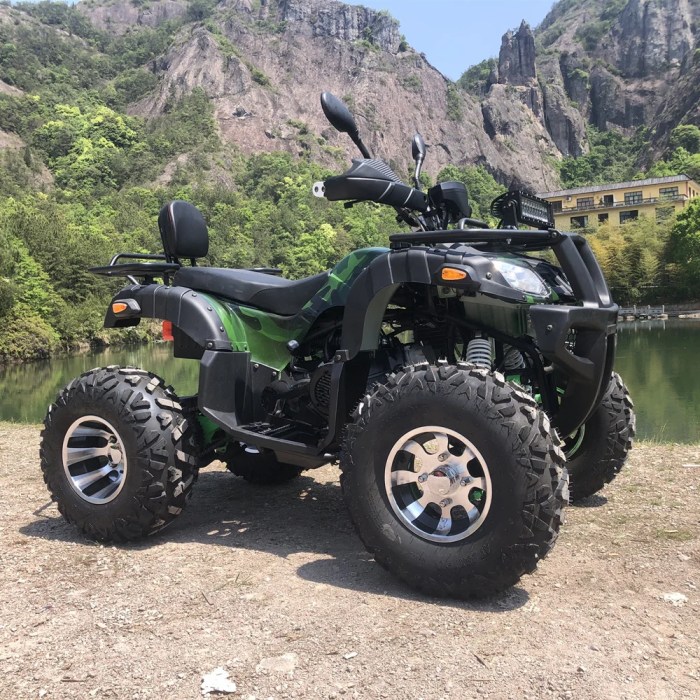Keeping your ATV running smoothly requires understanding its potential issues. This guide delves into four common problems—engine troubles, transmission difficulties, electrical system failures, and more—providing practical diagnostic steps and solutions. Whether you’re a seasoned rider or a novice, mastering these troubleshooting techniques will significantly enhance your ATV ownership experience, saving you time, money, and potential frustration on the trail.
From identifying the subtle signs of a failing engine to pinpointing electrical gremlins, we’ll equip you with the knowledge to tackle these challenges head-on. We’ll cover essential checks, explain common causes, and guide you through practical solutions, all presented in a clear and accessible manner. By the end, you’ll be better prepared to maintain your ATV’s peak performance and enjoy countless hours of safe and reliable riding.
Engine Problems

ATV engines, while robust, are susceptible to various issues stemming from neglect, misuse, or simply the wear and tear of off-road use. Understanding common engine problems, their symptoms, and basic troubleshooting techniques is crucial for maintaining your ATV’s performance and longevity. This section will cover diagnosing and addressing some of the most prevalent engine difficulties.
Common Causes of ATV Engine Failure
Several factors contribute to ATV engine failure. These include insufficient lubrication leading to seized bearings or piston damage; overheating due to low coolant levels or a malfunctioning cooling system; fuel system problems resulting in lean or rich fuel mixtures; and ignition system failures causing misfires or complete engine shutdown. Prolonged operation under heavy load without adequate cooling can also contribute significantly to engine damage. Regular maintenance, including oil changes, coolant flushes, and air filter cleaning, can greatly mitigate these risks.
Performing a Basic Engine Compression Test
A compression test measures the pressure inside the engine cylinders when the piston is at its top dead center. Low compression indicates problems like worn piston rings, valve issues, or a blown head gasket. To perform this test, you’ll need a compression tester specifically designed for your ATV’s engine.
- Disconnect the spark plug from the cylinder you are testing.
- Screw the compression tester into the spark plug hole.
- Fully depress the throttle and crank the engine over for several seconds.
- Record the highest reading displayed on the gauge.
- Repeat steps 1-4 for each cylinder.
Significant variations in compression readings between cylinders point to a problem within that specific cylinder. Consistent low readings across all cylinders suggest a more widespread issue, such as a worn piston ring across all cylinders or a faulty head gasket.
Expected Compression Values
The expected compression values vary depending on the engine size and type. The following table provides a general guideline; always consult your ATV’s owner’s manual for the manufacturer’s specified values.
| Engine Type | Cylinder | Expected Compression (psi) | Possible Issues |
|---|---|---|---|
| Single-cylinder, 250cc | 1 | 120-150 | Worn piston rings, valve problems, head gasket leak |
| Twin-cylinder, 500cc | 1 | 130-160 | Worn piston rings, valve problems, head gasket leak |
| Twin-cylinder, 500cc | 2 | 130-160 | Worn piston rings, valve problems, head gasket leak |
| Four-cylinder, 700cc | 1-4 | 140-170 | Worn piston rings, valve problems, head gasket leak |
Troubleshooting Starting Issues
Starting problems can be either electrical or mechanical. Electrical issues involve the battery, starter motor, ignition system, or wiring. Mechanical problems typically involve the engine itself, such as low compression, fuel delivery problems, or a seized engine.
A weak or dead battery will often result in a slow crank or no crank at all. A faulty starter motor may produce a clicking sound but fail to turn the engine over. Check the battery voltage and connections first, followed by testing the starter motor. If the battery and starter are functional, investigate the ignition system, including the spark plugs and coil.
Diagnosing a Faulty Carburetor or Fuel Injection System
A malfunctioning carburetor or fuel injection system will prevent proper fuel delivery to the engine. Symptoms include difficulty starting, poor performance, and stalling.
With a carburetor, inspect for clogs in the jets and passages. Cleaning the carburetor using carburetor cleaner and compressed air is often sufficient. If the problem persists, replacement may be necessary. Fuel injection systems require more specialized diagnostic tools. A fuel pressure test will determine if the fuel pump is delivering adequate pressure. Inspect fuel injectors for clogs or leaks. Professional assistance might be necessary for complex fuel injection system repairs.
Transmission Issues

Transmission problems in ATVs can significantly impact performance and safety. Understanding the common symptoms and diagnostic procedures can help you quickly identify and address these issues, preventing further damage and ensuring a smooth ride. This section will cover identifying symptoms, checking fluids, diagnosing CVT problems, and a troubleshooting flowchart.
Identifying Transmission Problems
Various symptoms indicate transmission trouble. Belt slippage, for example, results in sluggish acceleration and a whining or squealing noise, especially under load. Gear grinding, conversely, points towards internal mechanical issues within a manual transmission, manifesting as a harsh engagement or difficulty shifting gears. A complete lack of power transfer, regardless of throttle position, could signify a complete transmission failure or a serious issue with the drive chain or shaft. These issues can arise from low fluid levels, worn components, or improper maintenance.
Transmission Fluid Check
Regularly checking the transmission fluid level and condition is crucial for preventative maintenance. To do this, locate the transmission fluid dipstick (if equipped; some ATVs use sight glasses) usually near the engine. With the ATV on a level surface and the engine off, remove the dipstick, wipe it clean, reinsert it fully, and remove it again to check the level. The fluid level should be within the marked range on the dipstick.
- Healthy Transmission Fluid: Clean, bright red or amber (depending on the type), with a slight lubricating smell. It should be free of debris, metal shavings, or unusual discoloration.
- Unhealthy Transmission Fluid: Dark brown or black, cloudy, or contains metallic particles. A burnt smell often indicates overheating and potential damage. A milky appearance can suggest water contamination.
Diagnosing CVT System Problems
Continuously Variable Transmissions (CVTs) use belts and pulleys to provide a wide range of gear ratios. Belt wear is a common issue, often resulting in slippage, similar to the symptoms described earlier. Visually inspecting the belt for cracks, fraying, or excessive wear is the first step. Pulley issues can manifest as inconsistent shifting or complete failure. Examine the pulleys for damage, such as scoring or excessive wear on the surfaces where the belt engages. Listen for unusual noises during operation; whining or clicking sounds often indicate a problem within the CVT system. Excessive wear in the CVT system is often a result of prolonged use, poor maintenance, or operating the ATV under heavy loads or extreme conditions. For instance, regularly hauling heavy loads in muddy or sandy conditions will accelerate wear and tear.
Transmission Troubleshooting Flowchart
- Check Transmission Fluid Level and Condition: If low or dirty, replace the fluid.
- Inspect Drive Belt (if CVT): Replace if worn, cracked, or frayed.
- Inspect Pulleys (if CVT): Repair or replace if damaged.
- Check for External Damage: Inspect drive shafts, chains, and sprockets for wear or damage.
- Listen for Unusual Noises: Grinding, whining, or clicking sounds indicate internal problems.
- Test for Power Transfer: If no power is transferred, the problem is likely serious and requires professional attention.
Electrical System Problems

Electrical system failures in ATVs can be frustrating, leaving you stranded and unable to enjoy your ride. Understanding the common causes and troubleshooting techniques can significantly reduce downtime and increase your overall ATV experience. These problems often stem from simple issues easily resolved with basic tools and a little know-how.
Testing the ATV Battery
A dead or weak battery is the most frequent culprit in ATV electrical system failures. Before investigating more complex issues, always check the battery’s voltage. A multimeter is essential for this task. To test the battery, connect the multimeter’s red lead to the positive (+) terminal and the black lead to the negative (-) terminal. With the ATV’s ignition off, a fully charged battery should read between 12.6 and 13.2 volts. A reading below 12.2 volts indicates a low charge, and below 11 volts suggests a severely discharged or potentially faulty battery. If the reading is significantly lower than expected, attempt charging the battery. If the voltage remains low after charging, the battery needs replacement.
Diagnosing Lighting Problems
Malfunctioning lights—headlights, taillights, and brake lights—are common electrical issues. Systematic troubleshooting is key to identifying the problem.
- Check the Bulbs: Inspect all bulbs for physical damage or burnouts. A simple visual check is often sufficient to identify a faulty bulb. Replace any damaged bulbs with the correct wattage and type.
- Inspect the Fuses: Locate the ATV’s fuse box (often found near the battery or under a seat). Check each fuse related to the lighting system using a visual inspection or a multimeter to ensure there’s no break in the circuit. Replace any blown fuses with the correct amperage. Note that repeatedly blowing the same fuse indicates a more serious underlying problem, such as a short circuit in the wiring.
- Examine the Wiring: Carefully examine all wiring connected to the lights for any signs of damage, such as fraying, corrosion, or loose connections. Repair or replace any damaged wiring. Pay close attention to the connections at the bulbs and the switches.
Common Electrical Components and Failure Modes
Several electrical components can fail, leading to various symptoms. The following table summarizes common issues, testing procedures, and solutions.
| Component | Symptoms of Failure | Testing Procedure | Solutions |
|---|---|---|---|
| Battery | No power, slow cranking, dim lights | Measure voltage with a multimeter (see above) | Charge or replace battery |
| Voltage Regulator | Overcharging (battery boils), lights flickering | Measure voltage at the battery with the engine running; should be around 13.5-14.5V. A significantly higher voltage indicates a faulty regulator. | Replace voltage regulator |
| Starter Solenoid | Engine won’t crank, clicking sound when key is turned | Check for power at the solenoid terminals with a multimeter when the key is turned. A lack of power may indicate a faulty solenoid or related wiring. | Replace starter solenoid |
| Wiring Harness | Intermittent electrical problems, lights not working, etc. | Visually inspect for damage, shorts, or corrosion. Use a multimeter to check for continuity in suspect sections. | Repair or replace damaged wiring |
| Ignition Switch | No power to any electrical components | Check for power at the switch terminals with a multimeter when the key is turned. | Replace ignition switch |
Final Conclusion

Successfully diagnosing ATV problems empowers you to extend the life of your machine and avoid costly repairs. By systematically checking engine compression, transmission fluid, electrical components, and carefully observing symptoms, you can quickly identify and address most common issues. Remember, preventative maintenance and regular inspections are crucial for long-term reliability. With this knowledge at your fingertips, you can confidently tackle future challenges and enjoy the thrill of ATV riding with peace of mind.